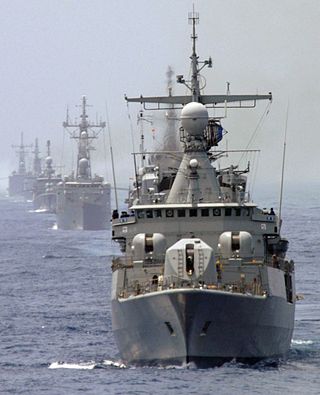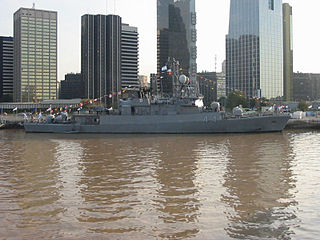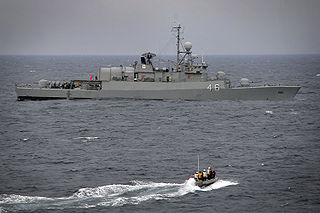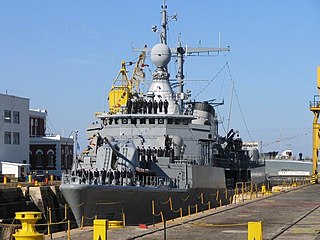
The Argentine Navy is the navy of Argentina. It is one of the three branches of the Armed Forces of the Argentine Republic, together with the Army and the Air Force.

Port Belgrano Naval Base is the largest naval base of the Argentine Navy, situated next to Punta Alta, near Bahía Blanca, about 560 km (348 mi) south of Buenos Aires. It is named after the brigantine General Belgrano which sounded the area in late 1824.

ARA Almirante Brown is the lead ship of the MEKO 360H2 series of four destroyers built for the Argentine Navy. The ship is the ninth ship in the history of the Argentine Navy to be named for Admiral William Brown, the founder and commander of the Argentine Navy during Argentina's war of independence against Spain.

ARA La Argentina is the second ship of the MEKO 360H2 series of four destroyers built for the Argentine Navy. The ship is the eighth ship in the history of the Argentine Navy to bear the name of the corsair frigate La Argentina which conducted a privateer raid around the world against Spanish trade in 1817.

ARA Heroína was the third ship of the MEKO 360H2 series of four destroyers built for the Argentine Navy. The ship was the third ship in the history of the Argentine Navy to bear the name of the corsair frigate Heroína, which claimed the Falkland Islands for the United Provinces of the River Plate on 6 November 1820.

ARA Sarandí is the fourth and last ship of the MEKO 360H2 series of destroyers built for the Argentine Navy. The ship is also the fourth ship in the Argentine Navy to bear that name. Sarandí is the name of a victory of the Argentine army during the Cisplatine War.

ARA Rosales (P-42) is the second ship of the MEKO 140A16 Espora class of six corvettes built for the Argentine Navy. The ship is the fourth ship to bear the name of Colonel (Navy) Leonardo Rosales, who fought in the Argentine Navy during Argentina's war of independence and the Cisplatine War.

ARA Spiro (P-43) is the third ship of the MEKO 140A16 Espora class of six corvettes built for the Argentine Navy. The ship is the second ship to bear the name of the Greek-born Captain Samuel Spiro, who fought during the Argentine War of Independence and blew himself up with his ship rather than surrender to the Spanish forces following the battle of Arroyo de la China, in 1814.

ARA Parker (P-44) is the fourth ship of the MEKO 140A16 Espora class of six corvettes built for the Argentine Navy. The ship is the second ship to bear the name of Captain Enrique Guillermo Parker, who fought in the Argentine Navy as its second-in-command during the Cisplatine War.

ARA Robinson (P-45) is the fifth ship of the MEKO 140A16 Espora class of six corvettes built for the Argentine Navy. The ship is the second ship to bear the name of British Captain Carlos Robinson, who fought in the Argentine Navy during the Cisplatine War and died commanding a squadron of gunboats during the Battle of La Colonia.

ARA Gómez Roca (P-46) is the sixth and last ship of the MEKO 140A16 Espora class of six corvettes built in Germany for the Argentine Navy. The ship is the first ship to bear the name of Lieutenant Commander Sergio Gómez Roca, who commanded the Argentine patrol ship ARA Alferez Sobral during the Falklands War and died in action when the ship was attacked by Royal Navy helicopters. Originally the ship was to have been named Seaver after Captain Benjamin Seaver, a US-born naval hero of the Argentine War of Independence.

The Espora-class corvettes are six warships of the Argentine Navy built in Argentina to the German MEKO 140A16 design, this in turn being based on the Portuguese João Coutinho-class project. The first entered service in 1985 but accidents and lack of funds meant the last was not completed until 2004. The ships currently form the 2nd Corvette Division of the Argentine Navy and their home port is the Puerto Belgrano Naval Base. Although considered by its designers to be frigates, the Espora-class vessels have been classed in Argentina as corvettes.

The Drummond class are three corvettes designed and built in France based on the A69 D'Estienne d'Orves-class avisos. The ships were commissioned in the Argentine Navy between 1978 and 1982.

The Intrépida class is a class of fast attack craft that was built by Lürssen for the Argentine Navy in the early 1970s. The ships are based on Lürssen's TNC 45 design.

ARA Guerrico (P-32) is a Drummond-class corvette of the Argentine Navy. She is the first vessel to be named after Rear Admiral Martín Guerrico who fought in the 19th century Paraguayan War.

ARA Granville (P-33) is a Drummond-class corvette of the Argentine Navy named after Guillermo Enrique Granville, who fought in the 1827 Battle of Juncal against Brazil.

The Sea Fleet Command is one of the commands in the Argentine Navy, headquartered at Puerto Belgrano Naval Base (BNPB).

ARA Almirante Bartolomé Cordero (P-54) is the fourth and final Gowind-class offshore patrol vessel constructed for the Argentinian Navy.

ARA Intrépida(P-85) is the lead ship of the Intrépida-class fast attack craft of the Argentine Navy. The ship is the lead ship of its class and has a twin sister ship ARA Indómita (P-86). She is the second ship of the Argentina Navy to bear the name Intrépida.

















